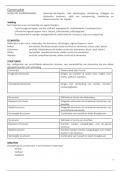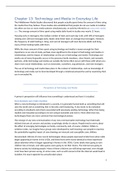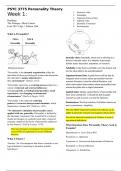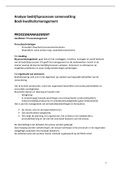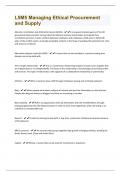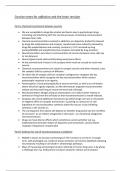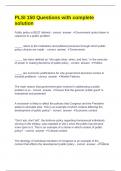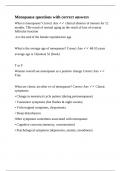Chapter 08
Family communication
Family communication is the primary source for socialization. Your parents or guardians shape the
ways in which you think about almost everything, from your own self to your views about the world
in general. Family communication instills and frames cultural values from the beginning and is a key
starting point for your sense of self and identity.
As Kathleen Galvin (2007) noted, “The greater the ambiguity of family form, the more elaborate the
communicative process needed to establish and maintain identity”. “Family” essentially depends on
a set of interconnected communicative relationships.
Families in truth and myth
Because family is seen as the root of socialization and in a small form of “society” itself, it is given
special attention in modern life. There is a strong tendency to
a. Separate family from other forms of relational interaction and
b. Idealize the concept.
FAMILIES AS SOCIAL IDEALS
Politicians, religious officials, and tax collectors all like the idea of a family. The media and politicians
also bombard you with images of good families, and there are debates about the way a family may be
constituted. There is a strong heteronormative pressure; there is a suspicion of countries or religions
that permit polygamous relationships. Bigamy is illegal, and adultery – which threatens the family
bonds – is disapproved; partners without children are not seen as a “family” (Steuber & Solomon,
2012). These views see a “family” as a stable structure, usually with a defined power hierarchy. The
traditional group is presented in advertising as a happy, supportive, quite comfortably wealthy, and
harmoniously understanding. Families are therefore supposed to be good for us. Le Poire, Hallett, and
Erlandson (2000) identifies two key defining functions as nurturing and control: A family nurtures,
supports and sustains its members, not only emotionally and educationally but also financially. The
family also exerts control over behaviour – socialization. There is a large set of social rules or norms
for “family” that monitors the way in which family life should be carried out. Labelling particular
people as “family” is a powerful way to establish expectations about how they should feel about one
another and communicate affection, loyalty, or membership.
NEGATIVE ASPECTS OF FAMILY
However, the fact is that families often present very negative experiences for people at least some of
the time. Many teenagers come to dislike their parents (for either a short or long period) as part of
the process of establishing an independent identity. Early experiences with parents can lead to
decreased self-esteem or to insecurities in later life relationships. Distant and aloof parents tend to
1
, produce children whose later personal relationships are characterized by distance, aloofness,
persecuted vigilance, and insecurity.
Although rates are declining, the family has long been known as the most violent social institution
outside of the military and by no mean are all families functional or even fun. People are more likely
to be assaulted, abused, or even murdered by a family member than by a random stranger. In part is
simply a consequence of the fact that, being close and intense, families tend to communicate all the
extremes of emotion. Their everyday communication may convey both love and hate, both peaceful
coexistence and outright open conflict. They also provide plenty of opportunities for a very rich range
of emotional experiences.
Families as…
Segrin and flora (2005) identified three ways of defining “family”: structural, functional, and
transactional. Structural definitions term a “family” as people who are related by blood, law or
adoption: functional definitions focus on the behaviours that make a family work well, such as mutual
support, socialization, and financial assistance; transactional definitions are based on the
communication that takes place within a group on a way that builds a sense of family identity.
FAMILIES AS FRAMES
For many purposes, families are seen primarily as social or demographic structures. This way of
seeing “family” is structural or genetic: who is in it, who is biologically or legally related to whom,
who is older, who is parent, who is offspring. Family is represented as an interconnected group of
individuals.
Le Poire (2006) noted that this particular structure of a family can be defined according to
a. Biological ties (genetics, bloodlines, or biological connectedness)
b. Legal definitions based on a person’s suitability to be a parent or a person’s right to have
custody of the children after a divorce, or
c. Sociological definitions
Groups that self-define themselves as families with an expectation of future
functioning as a “family”, many African Americans, e.g., define “family” to include kin
networks (cousins, second cousins, children of cousins…)
FAMILIES AS STRUCTURES
First representation is likely to be a nuclear family (i.e. just the parents plus their children).
Importantly, every nuclear family is a small family subgroup within a larger family conceptual group.
Two parents and the kids are nested within a group of the grandparents, cousins, broader families of
both parents – the extended family. You can also consider family of origin (the parents you were born
to), family of descent (the clan or historical family that you branch from), family of generativity (the
one you may start for yourself), or family of choice. This latter one may be created through adoption,
or may simply be the group of people you decide is your “true” family, even though there is no
genetic connection. When parents adopt nongenetic offspring, divorce or remarry other partners,
then so-called blended families are the result. The creation of one blended family can sometimes
2
Family communication
Family communication is the primary source for socialization. Your parents or guardians shape the
ways in which you think about almost everything, from your own self to your views about the world
in general. Family communication instills and frames cultural values from the beginning and is a key
starting point for your sense of self and identity.
As Kathleen Galvin (2007) noted, “The greater the ambiguity of family form, the more elaborate the
communicative process needed to establish and maintain identity”. “Family” essentially depends on
a set of interconnected communicative relationships.
Families in truth and myth
Because family is seen as the root of socialization and in a small form of “society” itself, it is given
special attention in modern life. There is a strong tendency to
a. Separate family from other forms of relational interaction and
b. Idealize the concept.
FAMILIES AS SOCIAL IDEALS
Politicians, religious officials, and tax collectors all like the idea of a family. The media and politicians
also bombard you with images of good families, and there are debates about the way a family may be
constituted. There is a strong heteronormative pressure; there is a suspicion of countries or religions
that permit polygamous relationships. Bigamy is illegal, and adultery – which threatens the family
bonds – is disapproved; partners without children are not seen as a “family” (Steuber & Solomon,
2012). These views see a “family” as a stable structure, usually with a defined power hierarchy. The
traditional group is presented in advertising as a happy, supportive, quite comfortably wealthy, and
harmoniously understanding. Families are therefore supposed to be good for us. Le Poire, Hallett, and
Erlandson (2000) identifies two key defining functions as nurturing and control: A family nurtures,
supports and sustains its members, not only emotionally and educationally but also financially. The
family also exerts control over behaviour – socialization. There is a large set of social rules or norms
for “family” that monitors the way in which family life should be carried out. Labelling particular
people as “family” is a powerful way to establish expectations about how they should feel about one
another and communicate affection, loyalty, or membership.
NEGATIVE ASPECTS OF FAMILY
However, the fact is that families often present very negative experiences for people at least some of
the time. Many teenagers come to dislike their parents (for either a short or long period) as part of
the process of establishing an independent identity. Early experiences with parents can lead to
decreased self-esteem or to insecurities in later life relationships. Distant and aloof parents tend to
1
, produce children whose later personal relationships are characterized by distance, aloofness,
persecuted vigilance, and insecurity.
Although rates are declining, the family has long been known as the most violent social institution
outside of the military and by no mean are all families functional or even fun. People are more likely
to be assaulted, abused, or even murdered by a family member than by a random stranger. In part is
simply a consequence of the fact that, being close and intense, families tend to communicate all the
extremes of emotion. Their everyday communication may convey both love and hate, both peaceful
coexistence and outright open conflict. They also provide plenty of opportunities for a very rich range
of emotional experiences.
Families as…
Segrin and flora (2005) identified three ways of defining “family”: structural, functional, and
transactional. Structural definitions term a “family” as people who are related by blood, law or
adoption: functional definitions focus on the behaviours that make a family work well, such as mutual
support, socialization, and financial assistance; transactional definitions are based on the
communication that takes place within a group on a way that builds a sense of family identity.
FAMILIES AS FRAMES
For many purposes, families are seen primarily as social or demographic structures. This way of
seeing “family” is structural or genetic: who is in it, who is biologically or legally related to whom,
who is older, who is parent, who is offspring. Family is represented as an interconnected group of
individuals.
Le Poire (2006) noted that this particular structure of a family can be defined according to
a. Biological ties (genetics, bloodlines, or biological connectedness)
b. Legal definitions based on a person’s suitability to be a parent or a person’s right to have
custody of the children after a divorce, or
c. Sociological definitions
Groups that self-define themselves as families with an expectation of future
functioning as a “family”, many African Americans, e.g., define “family” to include kin
networks (cousins, second cousins, children of cousins…)
FAMILIES AS STRUCTURES
First representation is likely to be a nuclear family (i.e. just the parents plus their children).
Importantly, every nuclear family is a small family subgroup within a larger family conceptual group.
Two parents and the kids are nested within a group of the grandparents, cousins, broader families of
both parents – the extended family. You can also consider family of origin (the parents you were born
to), family of descent (the clan or historical family that you branch from), family of generativity (the
one you may start for yourself), or family of choice. This latter one may be created through adoption,
or may simply be the group of people you decide is your “true” family, even though there is no
genetic connection. When parents adopt nongenetic offspring, divorce or remarry other partners,
then so-called blended families are the result. The creation of one blended family can sometimes
2


